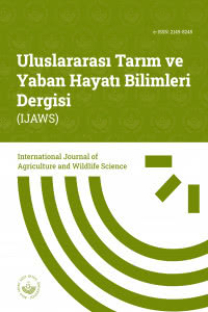Klorofil Floresan Metodu ile Ayrılan Farklı Olgunluk Dönemlerindeki Biber Tohumlarında Canlılık Parametrelerinin Tespiti
Biber, hasat dönemleri, klorofil floresan metodu, fungus, protein miktarı
Determination of the Viability Parameters in Pepper Seeds Separated by Chlorophyll Fluorescence Methodat Different Maturation Periods
Pepper, harvest periods, chlorophyll flourescence method, fungi, protein amount,
___
- Al-Kassim MY and Monawar MN., 2002. Seed-borne fungi of some vegetable seeds in Gazan province and their chemical control. Saudi Journal Biological Sciences, 7: 179-184.
- AOAC 1998. Official Method of Analysis. 15th Edition, Association of Official Analytical Chemists, Washington DC.
- Bewley JD and Black M., 1982. Viability, dormancy and environmental control. ‘In ‘Physiology and Biochemistry of Seed in Relation to Germination’ Vol.2, Springer-Verlag, Germany.
- Chiejina V., 2006. Studies on seed-borne pathogens of some nigerian melons, Agro-Science, 5(1): 13-16.
- Delouche JC., 1980. Environmental effects on seed development and seed quality. Hortscience, 15: 775-780.
- Demir İ and Ellis RH., 1992. Changes in seed quality during seed development and maturation in tomato. Seed Science Research, 2: 81-87.
- Demir İ., 1994. Changes in seed quality during seed development in tomato and pepper. II Symposium on Protected Cultivation of Solanacea in Mild Winter Climates, Adana-Turkey, August 1994, Acta Horticulture (ISHS), 366: 221-228.
- Demir I., Ermiş S., Mavi K and Matthews S., 2008. Mean germination time of pepper seed lots (Capsicum annuum L.) predicts size and uniformity of seedlings in germination tests and transplant modules. Seed Science and Technology, 36: 21-30.
- De Vos CHR., Kraak HL and Bino RJ., 1994. Ageing of tomato seeds involves glutathione oxidation. Physiologia Plantarum, 92(b): 131-139. Dinler H., Günay M., 2018. Determination of fungal agents in some vegetables seeds in greenhouse production areas in Uşak province. International Journal of Agriculture and Forestry, 8(2): 83-91.
- Er Y., 2010. Bazı sebze tohumlarında fungal floranın tespiti ve tanılaması. Yüksek Lisans Tezi, Selçuk Üniversitesi Fen Bilimleri Enstitüsü, Konya.
- Habib A., Sahi ST., Ghazanfar MU., Ali S., 2007. Location of seed-borne mycoflora of eggplant (Solanum melongena L.) in different seed components and impact on seed germinability. International Journal of Agriculture & Biology, 1560-8530(3): 514-516.
- ISO 1992. Method 10519. Rapeseed - Determination of chlorophyll content Spectrometric method. Geneva, International Organization for Standardization.
- ISTA, 1996. International Rules for Seed Testing, Annexes.
- ISTA 2003. International Seed Testing Association. International Rules for Testing Seed. Seed Science and Technology 21. İlbi H., 1998, Soğan tohumlarında yaşlanma ve yaşlanma ile oluşan vigor kayıplarının iyileştirilmesi. Doktora tezi, Ege Üniversitesi Fen Bilimleri Enstitüsü, İzmir.
- Jalink H., 1996. Werkwijze Voorhetbepalenvan de rijpheid en kwaliteit van zaden middelshet chlorofylgehalte en enrichtingvoorhetselecterenvan zaden met behulpvaneendergelijkewerkwijze.
- Jalink H., Frandas A., van Der Schoor R andBino JB., 1998. Chlorophyll fluorescence of the testa of Brassica oleracea seeds as an indicator of seed maturity and seed quality. Scientia Agricola, 55: 88-93.
- Khanal R., 1990. Literature Review on Vegetable Seed Storage and Packing, PAC Occasional Paper (6), Nepal.
- Konstantinova P., Van der Schoor R., Van den Bulk R and Jalink H., 2002. Chlorophyll fluorescence sorting as a method for improvement of barley seed health and germinaton. Seed Science and Technology, 30: 411- 421.
- Kwong FY., 1991. Research needs in the production of high quality seeds. Horticulture, New Technologies and Applications, (Eds. Prakash J And Pierek RLM), Kluwer Academic Publishers, Dordrecht, pp. 13-20.
- McDonald MB., 1998. Seed quality assessment. Seed Science and Technology, 8: 265-275.
- Neergaard P. 1988. Seed Pathology Vols. I and II, MacMillan Press, Hong Kong.
- Nishikawa J., Kobayashi T., Shirata K., Chibana T. and Natsuaki KT. 2006. Seedborne fungi detected on stored solanaceous berry seeds and their biological activities, Journal of General Plant Pathology, 72(5): 305-313.
- Noots I., Delcour JA and Michiels CW., 1998. From field barley to malt: detection and specification of microbia lactivity for quality aspects. Critical Reviews in Microbiology, 25: 121-153.
- Oluoch MO and Welbaum GE., 1996. Effect of postharvest washing and post-storage priming on viability and vigour of six-year-old muskmelon (Cucumis melo L.) seeds from eight stages of development, Seed Scince and Technology, 24(2): 195-209.
- Sharfun, N., Mushtaq M. and Pathan IH., 2004. Seed-borne mycoflora of Capsicum annuum imported from India. Pakistan Journal of Botany, 36(1): 191-197.
- Schwarz PB.,Casper HH., 1995. Fate and development of naturally occurring Fusarium mycotoxin during malting and brewing. Journal of the American Society of Brewing Chemistry, 53: 121-125.
- Sultana N., Azeem T. and Ghaffar A., 2009. Location of Seed-borbe Inoculum of Macrophomina phaseolina and its Transmission in Seedlings of Cucumber. Pakistan Journal of Botany, 41(5): 2563-2566.
- Steckel JRA., Gray D and Rowse HR., 1989. Relationships between indices of seed maturity and carrot seed quality. Annals of Applied Biology, 114: 177-183. Sehirali S. 1989. Tohumluk ve Teknolojisi. Ankara Üniversitesi Ziraat Fakültesi Basımevi, Ankara.
- TÜİK 2017. Bitkisel üretim istatistikleri. http://tuikapp.tuik.gov.tr/bitkiselapp/bitkisel.zul. [Erişim: 1 Temmuz 2017].
- Ward K., Scarth R., McVetty PBE and Daun J., 1992. Effects of genotype and enviroment on seed chlorophyll degradation during ripening in four cultivars of oilseed rape (Brassica napus). Canadian Journal of Plant Science, 72(3): 643-649.
- Ward K., Scarth R., Daun JK., Vessey JK., 1995. Chlorophyll degradation in summer oilseed rape and summer turnip rap during seed ripening. Canadin Journal of Plant Science, 75: 413-420.
- ISSN: 2149-8245
- Başlangıç: 2015
- Yayıncı: BOLU ABANT İZZET BAYSAL ÜNİVERSİTESİ > ZİRAAT VE DOĞA BİLİMLERİ FAKÜLTESİ
Fasulye Tohumunun Biyofortifikasyonu için Mineral İçerik Vasyasyonlarının Değerlendirilmesi
Tolga KARAKÖY, Mehmet Zahit YEKEN, Vahdettin ÇİFTÇİ, Hacer AKPOLAT
Nimet KATAR, DURAN KATAR, Doğan AYDIN, MURAT OLGUN
Abdelfattah Adnan DABABAT, Gul ERGINBAS ORAKCI, Alexey MORGOUNOV
Tuz Stresinin Sorgum×Sudanotu Melezinde Çimlenme ve Fide Gelişim Özelliklerine Etkisi
AYŞE ÖZGE ŞİMŞEK SOYSAL, GÜRKAN DEMİRKOL, ÖZLEM ÖNAL AŞCI, YELİZ KAŞKO ARICI, ZEKİ ACAR, NURİ YILMAZ
Bolu İli Patates Üretim Alanlarında Bitki Paraziti Nematodların Belirlenmesi
Assessment of Mineral Content Variations for Biofortification of the Bean Seed
MEHMET ZAHİT YEKEN, Hacer AKPOLAT, TOLGA KARAKÖY, VAHDETTİN ÇİFTÇİ
Bursa Bölgesinde Faaliyet Gösteren Üç Adet Broyler İşletmesinin Karbon Ayak İzinin Tahminlenmesi
